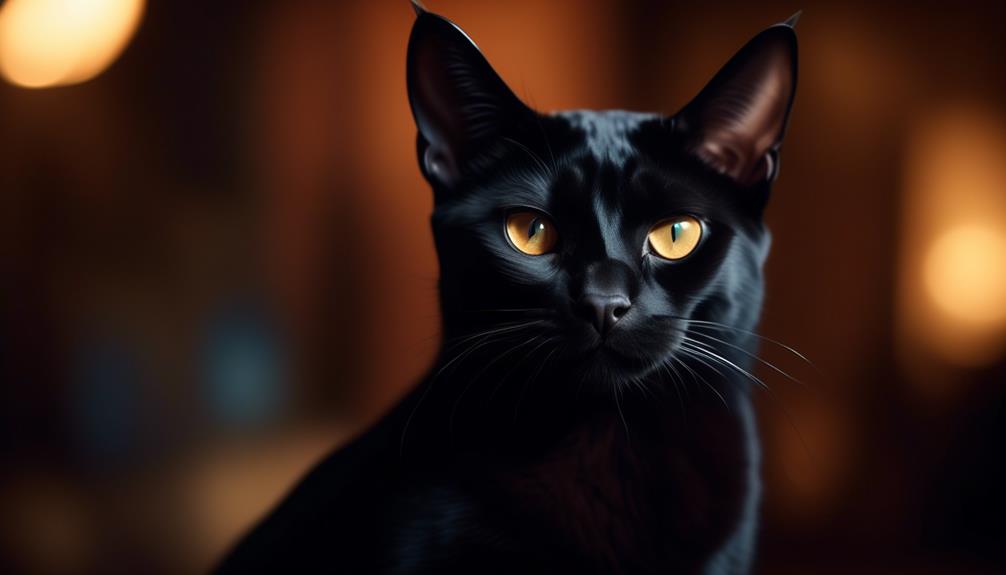
Welcome to our comprehensive guide on Bombay cats, where we will explore the captivating world of this unique feline breed.
With their origins in the United States, Bombay cats have gained recognition for their striking appearance and affectionate nature.
These medium-sized shorthair cats possess a jet-black coat, a black nose and paw pads, making them visually stunning.
However, there is more to discover about the Bombay cat breed beyond their physical characteristics.
From their intelligence and playfulness to their easy trainability, Bombay cats have a lot to offer as companions.
In this article, we will not only delve into their history and recognition but also provide valuable insights into their size, temperament, health, and care requirements.
Whether you are a novice or experienced cat owner, join us as we unravel the fascinating world of Bombay cats and equip you with the knowledge needed to make informed decisions.
Key Takeaways
- The Bombay cat breed is a medium-sized shorthair from the United States, known for its dense jet-black coat, intelligence, playfulness, and affectionate temperament.
- It is important to prioritize adopting from rescue organizations or reputable shelters, but if choosing to purchase from a breeder, thorough research should be conducted to ensure ethical breeding practices.
- Bombays have a lively and affectionate personality, adapt well to different environments and lifestyles, and can coexist with other pets, although they often prefer to be the dominant cat.
- While generally a healthy breed, Bombay may have genetic health issues such as hypertrophic cardiomyopathy (HCM) and craniofacial defects, which can be avoided through responsible breeding and researching breeder pedigrees. Regular grooming, dental care, and litter box maintenance are also important for their well-being.
General Information and Characteristics
The Bombay cat is a medium-sized breed known for its sleek, jet-black coat and affectionate temperament.
Originating from the United States, this shorthair breed has a 9-13 year lifespan.
With its short, dense coat and black nose and paw pads, the Bombay cat exhibits intelligence, playfulness, and a loving nature.
They require moderate exercise and are easy to train. Weekly brushing is sufficient for grooming.
However, it is important to note that the Bombay breed is prone to certain genetic health conditions, such as hypertrophic cardiomyopathy (HCM).
Developed by Nikki Horner in the late 1950s, the Bombay cat was named after the city of Bombay (now Mumbai), India. It was recognized by the Cat Fanciers Association in 1978.
See another cat breed profile.
Brazilian Shorthair Cat Breed
Origin and Breed Group
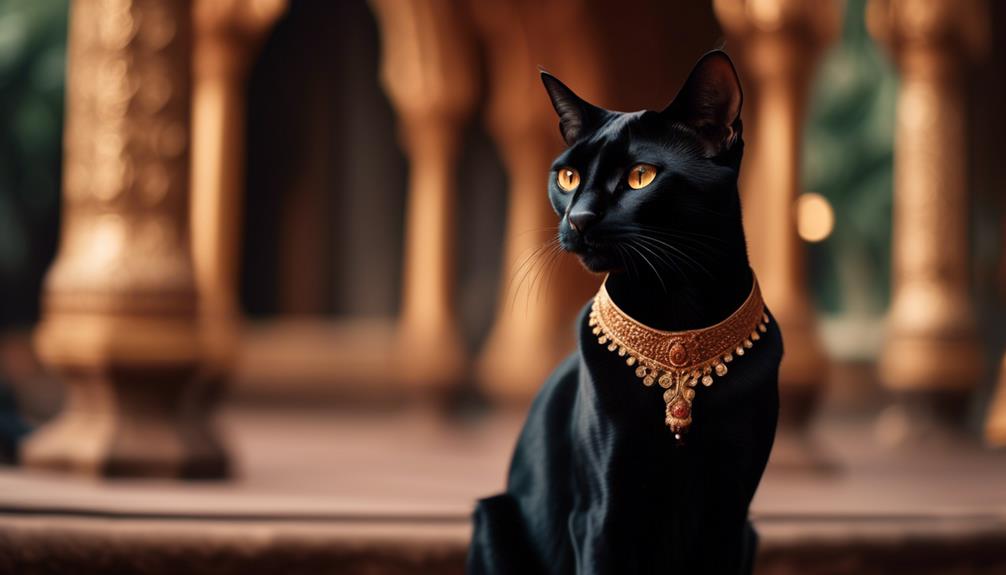
With its origins in the United States, the Bombay cat belongs to the shorthair breed group and is known for its sleek, jet-black coat and affectionate temperament.
This breed was created by crossing sable Burmese and black American Shorthair cats, resulting in a cat with a distinctive appearance and personality.
Bombay is named after the city of Bombay (now Mumbai), India, and was developed by Nikki Horner in the late 1950s.
British breeders also achieved a similar look and personality by using Burmese and black domestic shorthairs.
The Cat Fanciers Association recognized the Bombay breed in 1978.
Here is a table summarizing the origin and breed group of the Bombay cat:
| Origin | Breed Group |
|---|---|
| United States | Shorthair |
Size and Lifespan
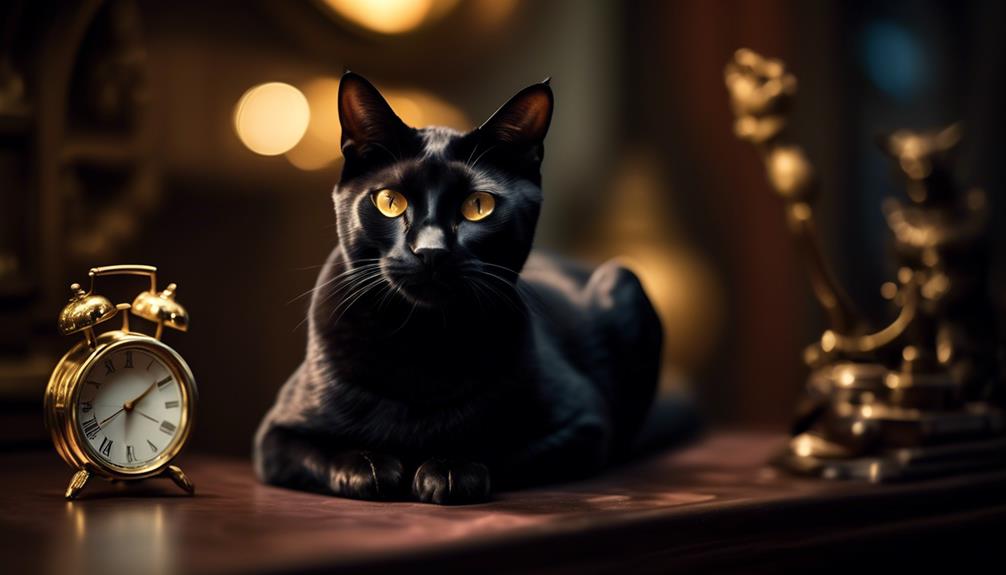
The Bombay cat is known for its size and lifespan. These medium-sized cats typically weigh between 8 and 15 pounds, with males generally larger than females.
Despite their compact size, Bombays have a long lifespan, typically between 9 and 13 years.
This breed’s adaptability to different environments and lifestyles, along with their calm nature, makes them well-suited for apartment living.
They are known for their lively and affectionate personality and usually get along well with other pets.
Although generally healthy, Bombay may have genetic health problems, including a craniofacial defect occasionally seen in newborn kittens.
It is important to research breeder pedigrees to avoid breeding cats with the gene for this defect.
Coat Description
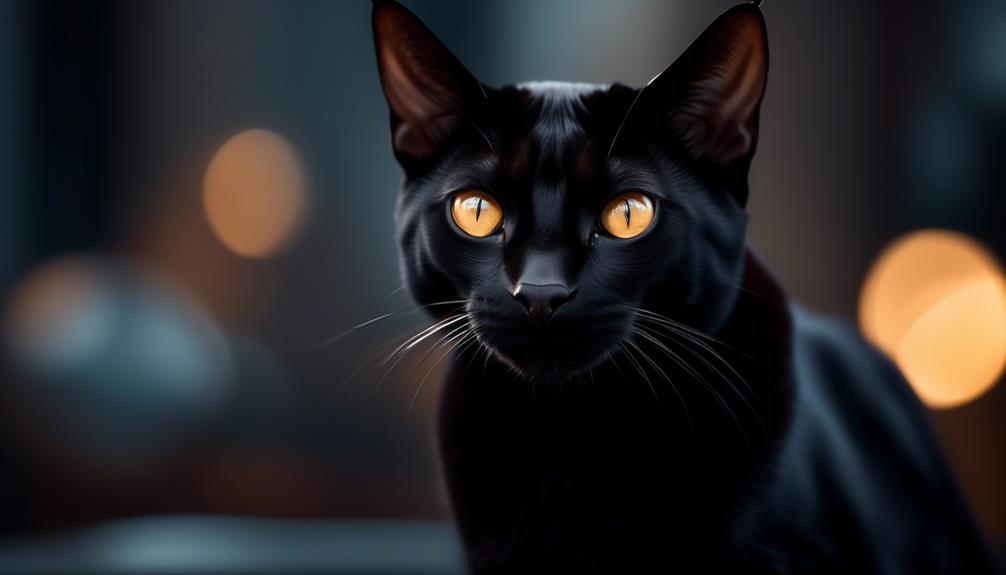
Bombay cats have a distinct coat that is short, dense, and jet black, with a black nose and paw pads.
Their coats are known for their sleek, glossy appearance, resembling patent leather.
The black color of their fur is solid and uniform throughout, without any markings or patterns.
This gives them a striking and elegant appearance.
The short length of their fur requires minimal grooming, making them relatively low-maintenance in terms of coat care.
Additionally, their dense fur protects them from the elements and helps keep them warm during colder weather.
The combination of their jet-black coat, black nose, and paw pads adds to their overall allure and distinguishes them as a unique and beautiful breed.
Temperament and Personality Traits
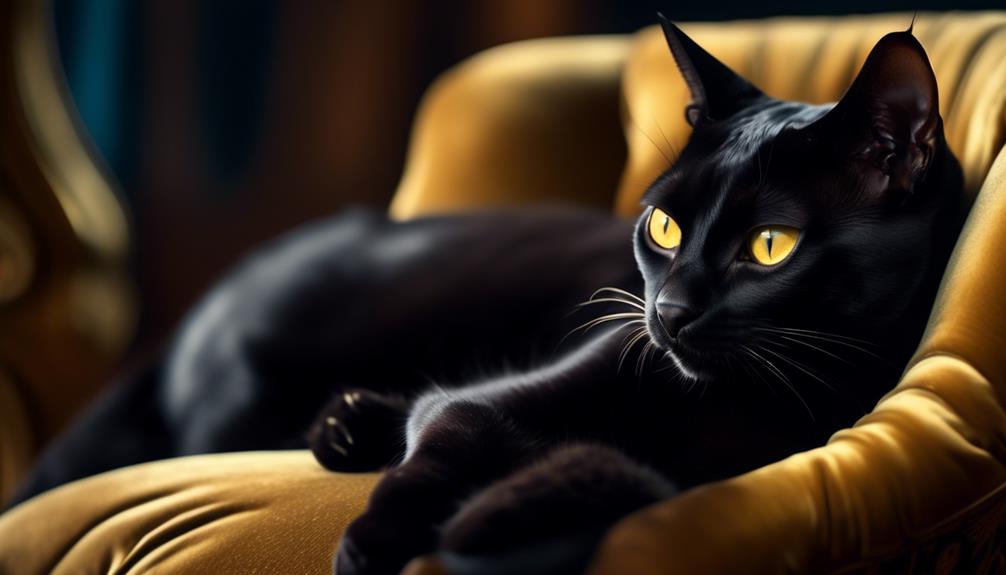
Moving on to the temperament and personality traits of the Bombay cat breed, their distinct coat is just one aspect of their overall allure.
Known for their lively and affectionate personality, Bombay cats are adaptable to different environments and lifestyles.
Their calm nature makes them well-suited for apartment living, and they can easily get along with other pets. However, they often strongly desire to be the top cat in the household.
With a moderate exercise requirement, Bombay cats are generally easy to train and enjoy interactive play.
They form strong bonds with their human companions and thrive on attention and affection.
Exercise Needs and Trainability
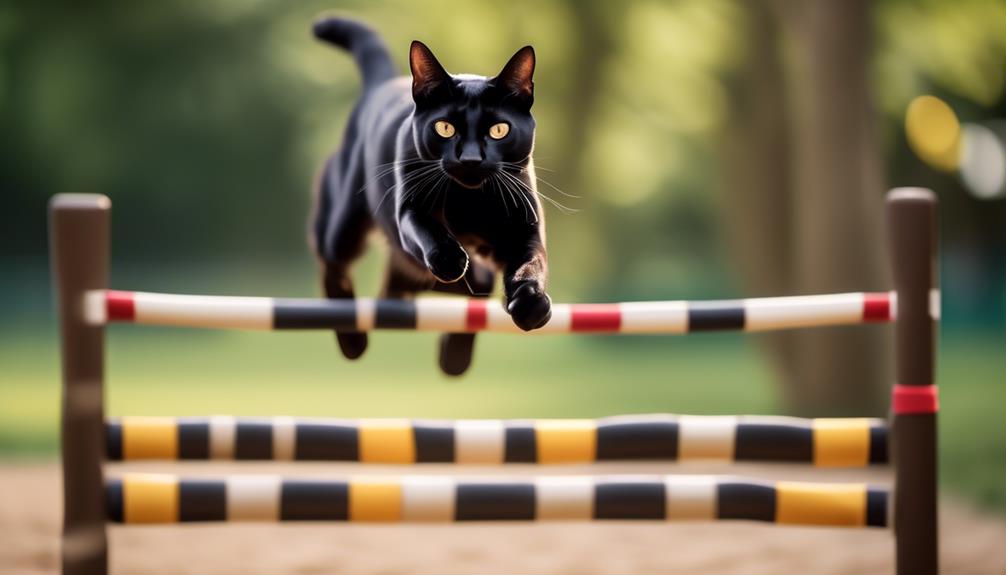
Exercise is an essential aspect of maintaining the health and well-being of the Bombay cat breed.
Although they have moderate exercise needs, regular physical activity is important to keep them fit and prevent obesity.
Engaging in play sessions with interactive toys or providing climbing structures can help fulfill their exercise requirements.
Additionally, mental stimulation is crucial for Bombay’s well-being.
They are intelligent cats and enjoy learning new tricks and solving puzzles.
Trainability is another notable characteristic of the Bombay breed.
They are quick learners and can be easily trained using positive reinforcement techniques.
Their affectionate and social nature makes them eager to please their owners.
Bombay can excel in agility training and interactive games with consistent training and positive reinforcement.
Grooming Requirements
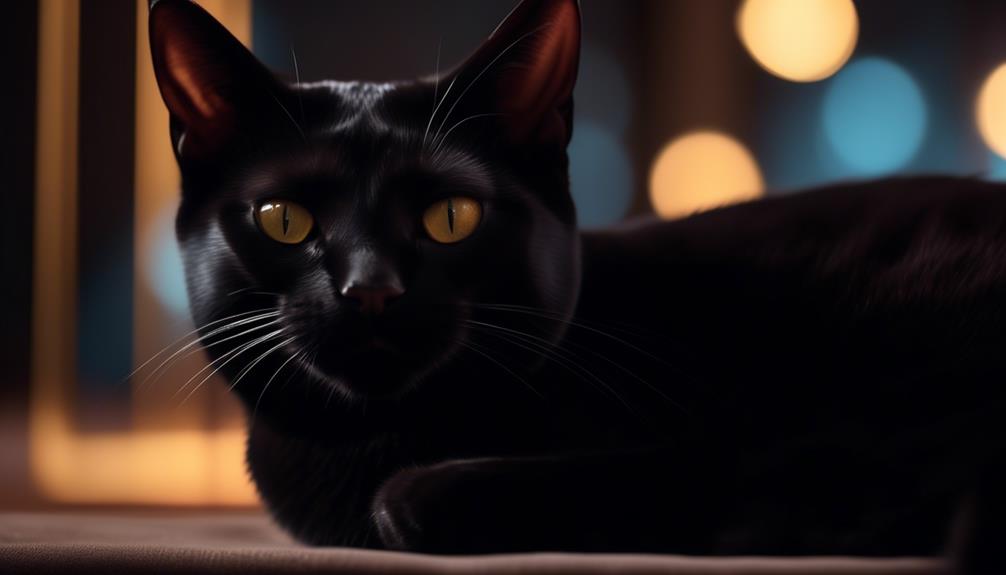
To properly care for a Bombay cat, it is important to understand their grooming requirements.
Fortunately, the Bombay’s short, sleek coat is easily cared for and requires minimal grooming.
Weekly brushing is usually sufficient to keep their coat in good condition and prevent matting.
Additionally, it is important to regularly brush their teeth to prevent periodontal disease and wipe the corners of their eyes to remove any discharge.
Keeping their litter box clean and spaying or neutering them at the appropriate age is also essential for their overall health and well-being.
Genetic Health Conditions
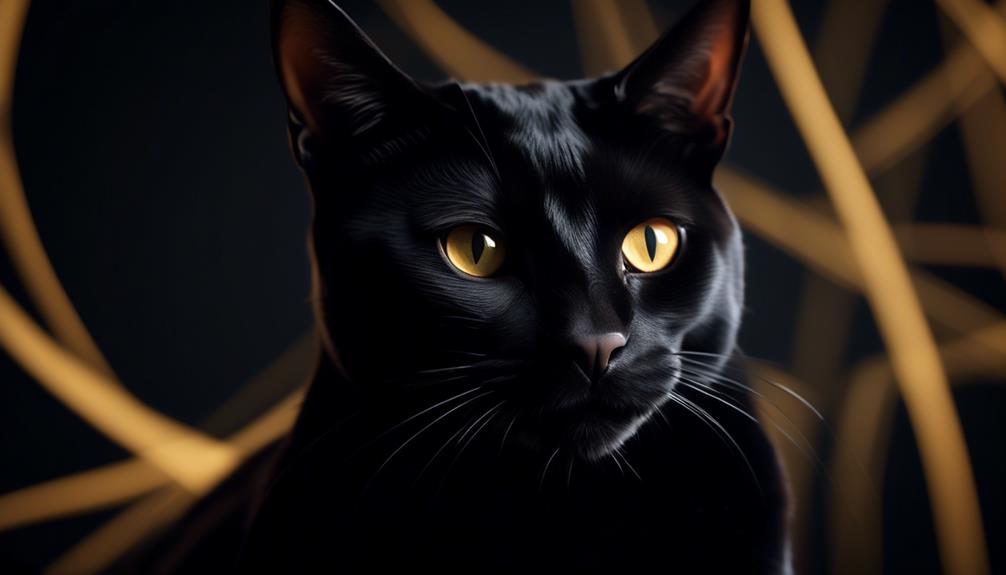
The Bombay cat breed is known to be prone to certain genetic health conditions, such as hypertrophic cardiomyopathy (HCM).
This condition affects the heart muscles, causing them to thicken and potentially leading to heart failure. Regular veterinary check-ups and screenings are recommended to detect and manage this condition early.
Another genetic health issue that can occasionally be seen in newborn Bombay kittens is Craniofacial Defect.
To prevent this defect, it is important to research the pedigrees of breeding cats and avoid mating cats that carry the gene for the defect.
Bombay History and Recognition
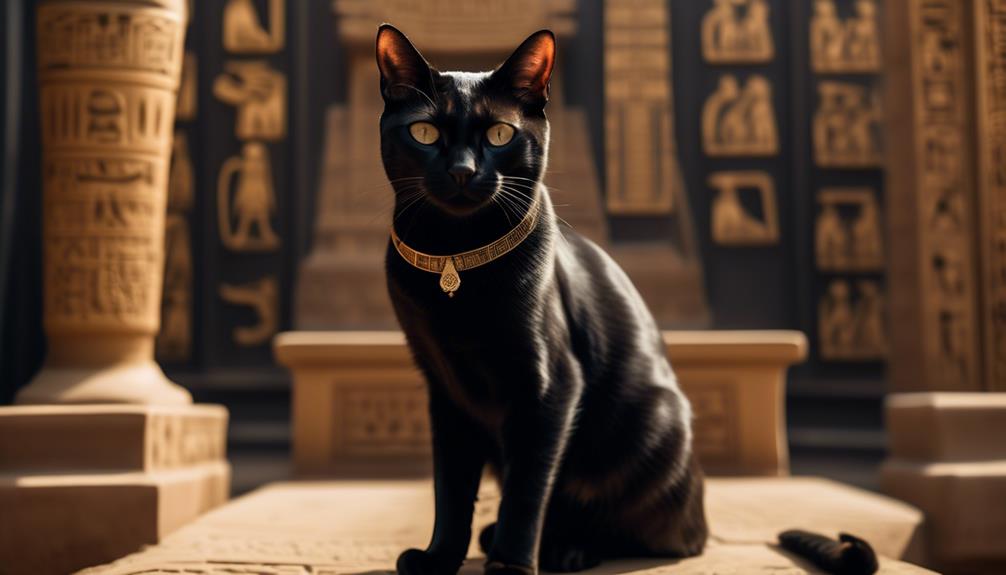
The history and recognition of the Bombay cat breed are fascinating and important aspects of understanding this unique feline.
The breed was created by crossing sable Burmese and black American Shorthair cats, resulting in a cat with a sleek, jet-black coat and a loving personality.
The breed was named after the city of Bombay (now Mumbai), India, and was developed by Nikki Horner in the late 1950s.
British breeders also achieved a similar look and personality using Burmese and black domestic shorthairs.
The Bombay cat breed was officially recognized by the Cat Fanciers Association in 1978. This recognition has solidified the breed’s place in the feline world and allowed its continued preservation and promotion.
Development and Naming
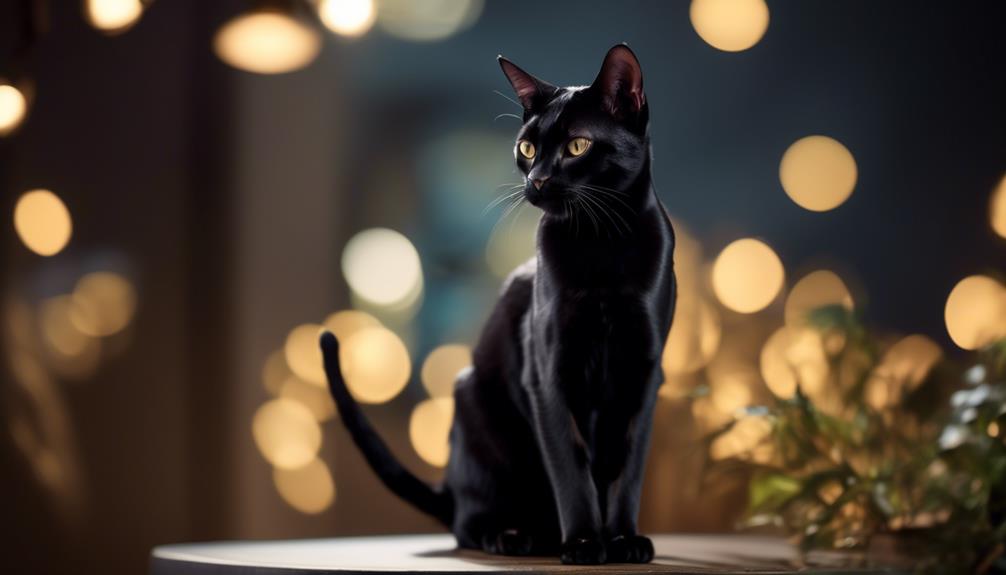
Continuing the exploration of the Bombay cat breed, we now delve into its development and the fascinating process behind its naming.
The Bombay breed was created in the late 1950s by Nikki Horner, an American breeder.
She crossed sable Burmese cats with black American Shorthair cats to achieve the desired look and temperament.
The breed was named after the city of Bombay, now known as Mumbai, in India.
British breeders also achieved a similar appearance and personality by using Burmese and black domestic shorthairs.
The Cat Fanciers Association recognized the Bombay breed in 1978. This recognition solidified the breed’s status and popularity among cat enthusiasts.
The development and naming of the Bombay breed highlight the careful selection and breeding practices carried out by dedicated breeders to create a unique and beloved feline companion.
Recognition by Cat Fanciers Association
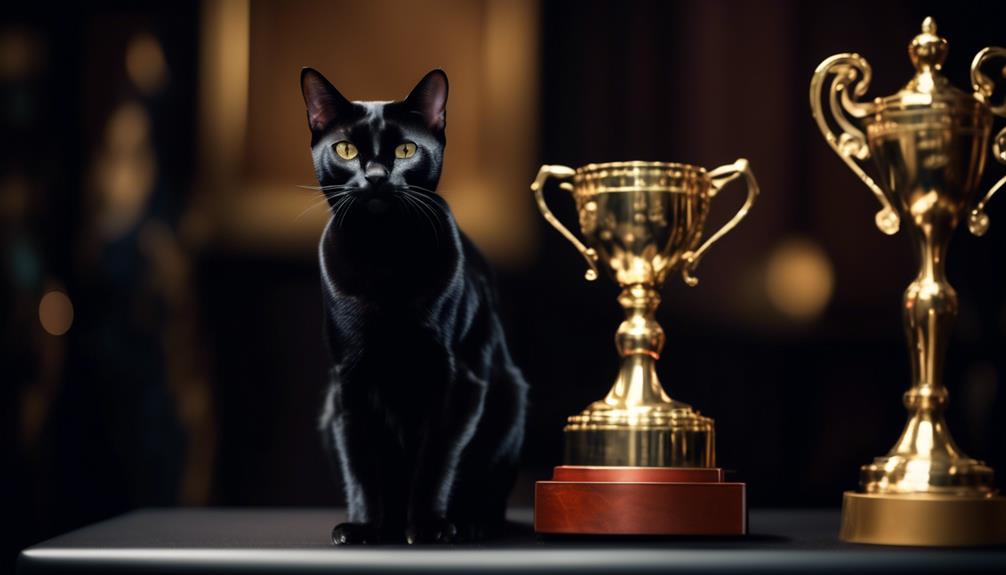
Recognized for its unique characteristics and popularity among feline enthusiasts, the Bombay breed gained official recognition by the Cat Fanciers Association.
This prestigious recognition by the CFA highlights the breed’s exceptional qualities and confirms its status as a distinct and valuable breed within the feline world.
The recognition by the CFA signifies that the Bombay breed meets the established breed standards, ensuring consistency in appearance, temperament, and overall quality.
It also means that Bombay cats are eligible to compete in CFA-sanctioned cat shows and events, allowing breeders and owners to showcase their cats and receive recognition for their breeding efforts.
This recognition by the CFA further solidifies the Bombay breed’s place in the world of purebred cats and acknowledges its importance in the feline community.
Adopting and Responsible Breeding
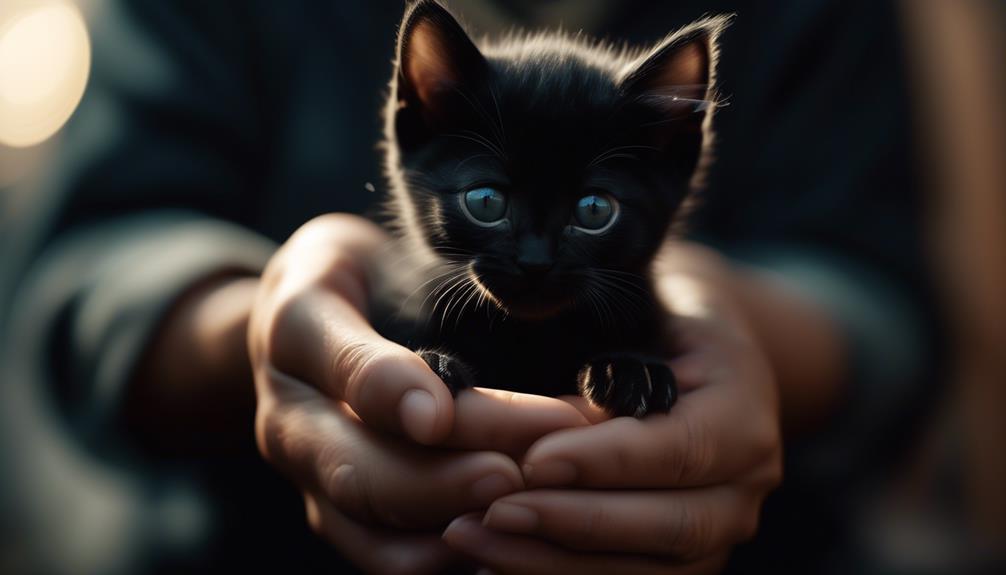
To ensure the well-being of cats and promote ethical practices, it is important to prioritize adopting from rescue organizations or shelters and choose a reputable breeder when considering the adoption or purchase of a Bombay cat.
By adopting from rescue organizations or shelters, you not only provide a loving home for a cat in need but also contribute to reducing the number of cats in overcrowded shelters.
When purchasing from a breeder, it is crucial to conduct thorough research on their practices.
Reputable breeders prioritize the health and temperament of their cats, and they should be able to provide you with the necessary documentation and information about the cat’s lineage.
By choosing responsible breeding practices, we can help ensure the continued well-being of the Bombay cat breed.
| Advantages of Adopting from Rescue Organizations or Shelters | Advantages of Choosing a Reputable Breeder |
|---|---|
| Saving a cat’s life and providing a loving home | Ensuring the health and temperament of the cat |
| Reducing the number of cats in overcrowded shelters | Obtaining necessary documentation and information about lineage |
| Supporting ethical practices in cat adoption | Promoting responsible breeding practices |
Importance of Rescue Organizations and Shelters
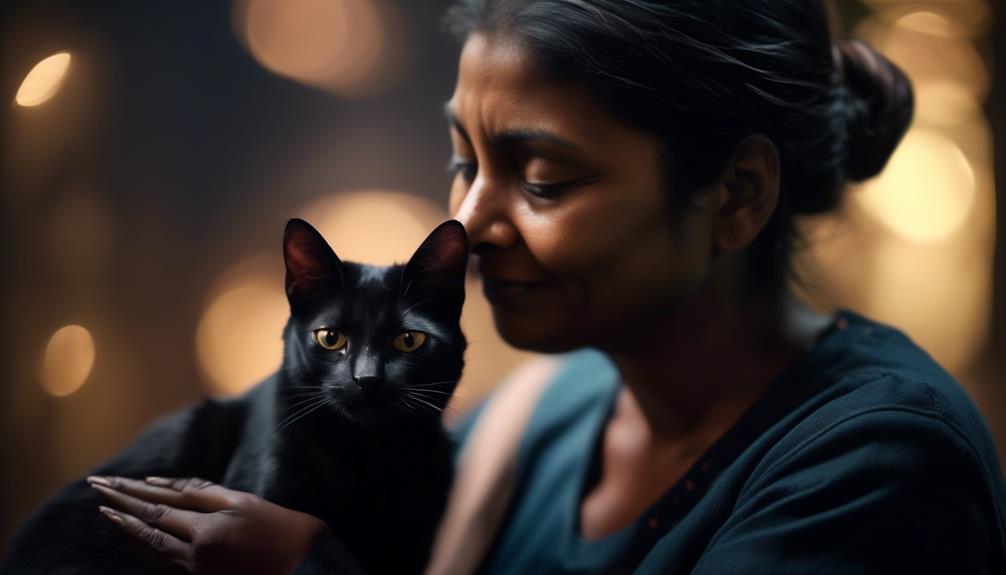
Rescue organizations and shelters play a crucial role in ensuring the welfare and future of the Bombay cat breed.
Here are three reasons why they are important:
Saving Lives:
Rescue organizations and shelters provide a haven for abandoned, neglected, and stray Bombay cats.
They rescue these cats from dangerous situations and give them a chance at a better life.
By adopting from these organizations, individuals can help save the lives of these beautiful cats.
Promoting Responsible Ownership:
Rescue organizations and shelters educate potential owners about the responsibilities of owning a Bombay cat.
They guide proper care, nutrition, and veterinary needs.
This helps ensure the cats are placed in loving and responsible homes, reducing their chances of being abandoned or mistreated.
Choosing a Reputable Breeder
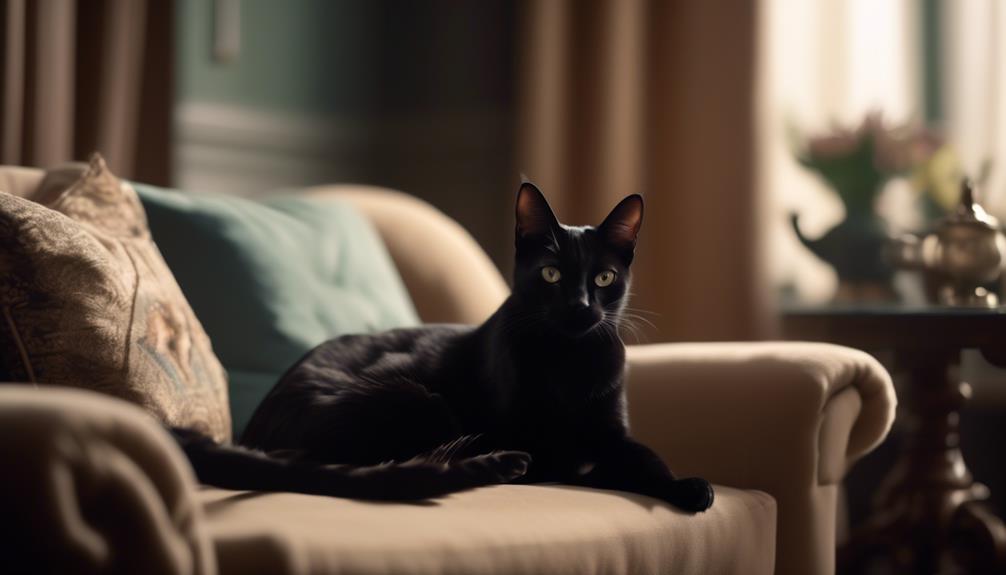
Responsible ownership of a Bombay cat starts with carefully selecting a reputable breeder who prioritizes the health and well-being of their cats.
When choosing a breeder, conducting thorough research on their practices is important.
Reputable breeders prioritize the health and temperament of their cats and discourage unethical breeding practices.
They should be able to provide you with information about the breed’s genetic health conditions, such as hypertrophic cardiomyopathy (HCM), and show proof of health testing for their breeding cats.
Additionally, a reputable breeder will allow you to visit their facilities and meet the cats in person, ensuring they are well-cared for and raised in a clean and loving environment.
Frequently Asked Questions
Are Bombay Cats Hypoallergenic?
Bombay cats are not hypoallergenic.
While they may produce fewer allergenic proteins than some breeds, they still produce enough to trigger allergies in sensitive individuals.
Regular grooming and keeping a clean environment can help reduce allergens.
How Long Does It Take for a Bombay Cat to Reach Its Full Size?
The Bombay cat typically reaches its full size within the first year of life.
Males are generally larger than females, and the breed has a medium-size range of 8 to 15 pounds.
Can Bombay Cats Be Left Alone for Long Periods?
Bombay cats are generally adaptable and can tolerate being alone for moderate periods.
However, like other cats, they need social interaction and mental stimulation.
It is recommended to provide them with companionship and enrichment to prevent loneliness and boredom.
Do Bombay Cats Get Along Well With Children?
Bombay cats generally get along well with children.
They have a lively and affectionate personality, making them adaptable to different environments and lifestyles.
However, it’s important to supervise interactions to ensure the cat’s and child’s safety and well-being.
Are Bombay Cats Prone to Obesity?
Bombay cats are not inherently prone to obesity, but like any other cat, they can become overweight if they are overfed or have a sedentary lifestyle.
Proper portion control, regular exercise, and a balanced diet are key to maintaining a healthy weight.
Conclusion
In conclusion, Bombay cats are a unique and fascinating breed known for their striking appearance and affectionate temperament.
Their short, dense, jet-black coat and playful personality make ideal companions for novice and experienced cat owners.
While they may be prone to certain genetic health conditions, such as hypertrophic cardiomyopathy, responsible breeding and adoption can help mitigate these risks.
Bombay cats are intelligent and loving and make wonderful additions to any family.




